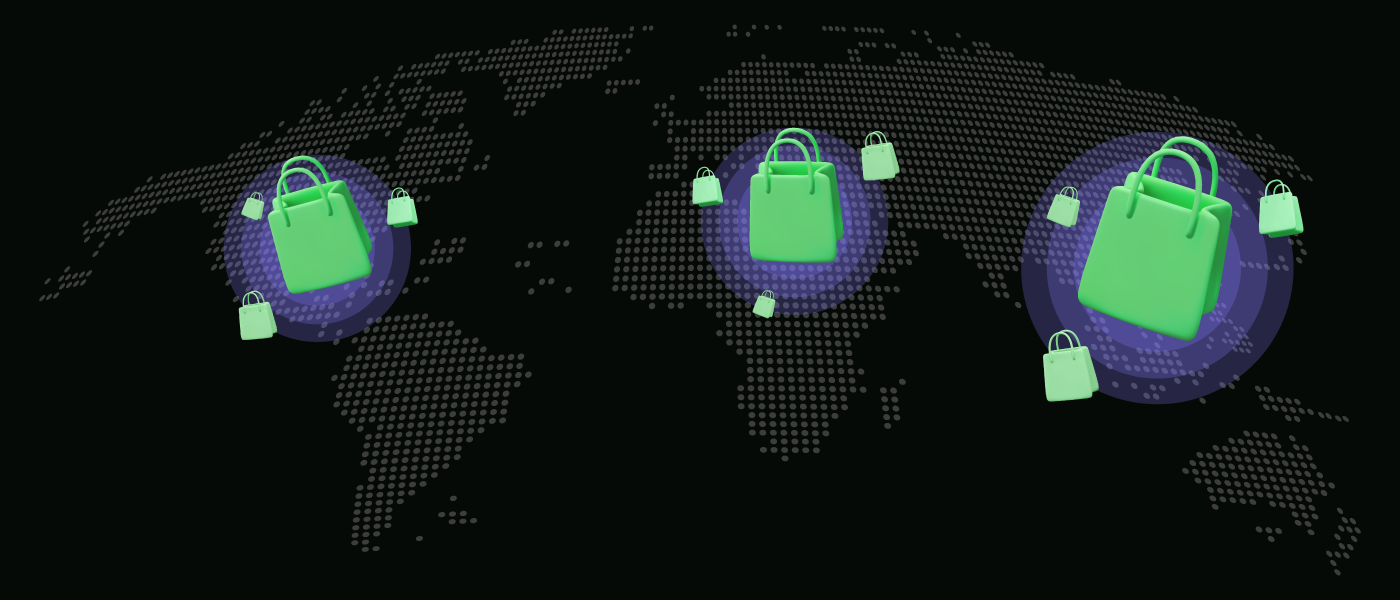The past few years have seen a fundamental, and presumably permanent, shift in consumer buying behavior, rapidly expanding e-commerce options, the growth of shopping platforms, marketplaces, and next-day delivery. This has forced retailers, manufacturers, shippers, and fulfillment partners to completely tear down the old model and shift to essentially new methods of localized and hyperlocal fulfillment across eCommerce, buy-online/pick up in-store (BOPIS), or in-store purchasing. This new model of fulfillment, however, comes with a series of challenges.
Regardless of which option a consumer picks, there’s one consistent factor – consumers want their products for a low price, minimal to no shipping costs, same day or next day delivery, hassle-free returns, and always-in-stock inventory, just to start. Referred to as the Amazon Effect, this has set a high precedent for online retailers to try to compete with those features, otherwise, they’ll find themselves left behind by consumers. As the past year has negated the in-store bricks and mortar shopping option, consumers are relying more on online ordering and direct-to-door delivery, or via curbside delivery. Again, as quickly and as cheaply as possible.
This has had a huge impact on how today’s supply chain fulfillment strategy works – hence a Localized strategy via Hyperlocal Fulfillment.
What is Localized Fulfillment?
As of late, today’s eCommerce fulfillment market has been hampered by 5 major factors:
- Delivery routes are saturated with inner-city congestion.
- Rising delivery costs.
- Increasing demand for instant fulfillment.
- Skyrocketing prices for conventional distribution center real estate.
- COVID-19’s effects on air/sea/ground transportation.
These are essentially the 5 horsemen of the retail apocalypse and have been a thorn in the side of logistics managers. When the aim is to fulfill customer orders in this environment while maintaining an acceptable profit margin, it seems to be an impossible situation. But, in actuality, it’s not. Not anymore. It just means that it’s time to let go of the remote, gigantic Distribution Centers (DCs), and conquer the last-mile challenge with a new model and make order fulfillment easier and more scalable.
Localized fulfillment is going in-country rather than shipping from a central DC for all of Asia Pacific/SEA. Initially, when starting out, an eCommerce retailer will look to cross-border fulfillment due to the fact that there is less risk and startup costs, and you can test the local markets before really diving in. This method, however, is prone to certain negative characteristics – shipping requires longer delivery lead times, at a higher shipping cost, and a higher risk of supply chain interruptions. From a customer experience perspective, this translates to a lower conversion rate/sales/repurchasing as customers prefer to order goods fulfilled locally with less uncertainty about the expected delivery date, generally faster shipping, and lower shipping cost.
Then expound that this trend is further amplified by COVID19 which has introduced many disruptions to cross-border eCommerce. Due to the decline in commercial air travel, not enough passenger flights are available to carry commercial shipments such as eCommerce packages. Prior to 2020, 50% of the world’s air cargo was carried in the belly of passenger aircraft. With that no longer an option, it has led to much longer delivery lead times in cross-border shipping ranging from a few weeks to months for transatlantic routes. Customers are avoiding cross-border orders due to the uncertainty about when they will get their package.
In addition whatever airfreight capacity is left has sharply increased in price, making this often unviable for eCommerce shipments. For example, in the past, air freight rates used to fluctuate within a $3-$4 per kilogram range. But with decreased traffic, routes from Asia to the US rose over $20 a kilogram, with many importers trying to outbid and undercut their competition. This means carriers had to find alternatives to air freight for eCommerce shipments which are naturally much slower – in most of Asia Pacific this means sea freight or by road.The first step for brands and merchants who are serious about improving their supply chain and their delivery time is to localize fulfillment, putting fast-moving stock in the country or region closer to their customers.
What does Hyperlocal Fulfillment Mean?
Hyperlocal fulfillment relies on small and numerous fulfillment centers (FCs) that are located in urban centers. They can be right downtown, relatively close to the core, or in heavily populated areas within the city and/or suburbs. This is where stock can be stored and shipped for eCommerce orders. By bringing the product closer to the customer, orders can be fulfilled faster, dispatched sooner on a smaller footprint, and employ innovative final mile delivery solutions.
What does this look like? Instead of the old strategy where the product went from a DC, straight to the store where the end-users purchased it or sent it to the purchaser at home regardless of where they are geographically, now brands and eCommerce entrepreneurs are adopting omnichannel fulfillment. While the move to omnichannel isn’t anything entirely new – it existed prior to COVID-19 and was relatively popular for home delivery and BIPOS, the pandemic only accelerated its growth in tandem with Amazon’s aggressive expansion. Now, there are multiple fulfillment channels that make sure the right product is found, allocated, and delivered to the buyer as seamlessly and as quickly as possible, via a distributed warehouse fulfillment process, in-store product pickups, dropshipping, and home delivery. This can happen by the next day, the same day, or even within the hour. This is the way to get ahead and make your eCommerce business a success.
Finding the right fulfillment partner that offers hyperlocal fulfillment and a distributed network, is a key to this success.

E-commerce is Growing at a Rapid Rate
To really understand why hyperlocal fulfillment is such a key differentiating factor, you should understand the market conditions that led to this. The rise of eCommerce has been one of the greatest disruptors to supply chain operations in the past 20+ years or so. In fact, China’s eCommerce Gross Merchandise Volume (GMV) reached 51% of total retail spend in 2020, meaning that for the first time, there was more shopping done online, than offline. In the Philippines, eCommerce has driven significant growth at 55% YoY, according to research conducted by Google, Temasek, and Bain & Company. The same can be seen in Australia, with 65% more Australians shopping online, leading to an 85.3% YoY growth in eCommerce.
On the vendor front, the numbers are no different. Various eCommerce sites such as Lazada, Shopee, and Sendo have seen a 63% increase year over year in certain countries, according to Think With Google. Regardless of whether or not they’re staying at home, or allowed to shop in person again, recent months have shown more and more consumers turning to eCommerce sites for the first time. Singapore, for example, showed that 24% of their online buyers during their Circuit Breaker period were new buyers, and 74% said that they’d continue buying online post-lockdown.
It’s also more than just more people buying online, it’s also new sellers. Shopify saw a 62% surge in new stores created between March and April of 2020, which Google search queries for “seller” in SEA grew more than 20% in May last year, compared to the previous months.
This has had a painful impact on bricks and mortar stores. As more purchasing has moved online, they’ve had to pivot their strategies to selling online. This has meant that there’s been less of a need for physical stores within the core. While this has been bad news for physical retailers, it’s been good for eCommerce. This mass exodus from storefronts and big box stores has freed up inner-city and suburb real estate and any associated infrastructure, allowing retailers and fulfillment partners to repurpose those assets into local distribution hubs.
Congestion And High Delivery Costs
It’s a plain fact for anyone who’s in the eCommerce space – if your delivery costs are too high, you’ll never make any money. Customers don’t want to pay for the last mile, even though they’re demanding that the orders arrive the same day or the next day, or else they’ll go elsewhere. According to a study by Arvato, free shipping is one of the largest motivators to an online shopper. As many as 58% of shoppers will add to their cart to qualify for free shipping, while 54% will abandon their cart if the shipping costs too much. Hence, you need to absorb the cost of shipping or add it to your costs.
At the same time, however, cities are becoming increasingly more densely populated. Asia, for example, has 30% of the world’s land with 60% of the world’s population, with the highest growth rate. While China is the most populated country in Asia, Indonesia, the Philippines are within the top 10 with upwards of 255 million and 102 million people respectively. While not every inch of Asia Pacific is densely populated, inner-city traffic congestion and restricted ground/air/sea shipping eat up too much time during the day and far too much expensive fuel. This means the cost of shipping from a central location to a customer’s door is escalating. It’s estimated that the last mile for eCommerce orders accounts for 53% of the total cost of shipping.
Hyperlocal fulfillment allows for easy pickup and delivery strategies, by placing the fulfilled order close to the customer’s home. On one hand, it can put the onus on the customer via BOPIS, curbside delivery to have them pick it up and avoid the last mile. Or, the other answer is a distributed network of fulfillment centers and preferred rates with shippers to get the product to a customer’s door swiftly without crazy costs.
The Demand For Instant Fulfillment
Finally, the biggest problem that eCommerce retailers and shippers deal with – Amazon’s ever-accelerating fulfillment speed. Now, eCommerce is a continuous race – who can check out faster and easier, and then race to the front door. Same-day delivery for urban customers has become the norm, to the point that the bar is moving even higher with shorter delivery windows on offer. This leaves smaller retailers and operators struggling to keep up with demand and expectations. According to a survey, 24% of online shoppers would pay extra to have their products delivered within 1-2 hours of ordering. In fact, some shoppers consider at the rate that shipping speeds are increasing, a pizza delivery-style “30min or free” will soon become the expectation.
If, however, you can start your delivery mere miles or blocks from the customer, instead of across borders and many miles, you can reduce the order to delivery time significantly. This is where localized distribution comes into play and hyperlocal fulfillment offers this eCommerce challenge. Three blocks for delivery isn’t all that long to wait. Especially with the proliferation of Uber-style delivery services, drones, or bike courier services.
LOCAD Offers Best-in-Class Hyperlocal Fulfillment
At LOCAD, we pride ourselves in helping startups and entrepreneurs in the eCommerce space, putting their products in their customers’ hands quickly and easily, via hyperlocal fulfillment. LOCAD’s dynamic and scalable technology solution is a supply-chain-as-a-service platform that can solve your last mile expenses, and facilitate a best-in-class fulfillment experience.
Our solution offers access to a globally distributed fulfillment network to help you localize your fulfillment strategy via a customized supply chain design that can integrate with your eCommerce store. As you scale up, we can help you broaden your reach with our distribution warehousing network and order/inventory management, to help you stock, store, and ship your own products. We also offer:
- Efficient integration with your Sales Channels (website, marketplaces, shop platforms).
- With our localized network, more than 90% of orders are outbound and dispatched in 24hrs.
- Demand/Supply planning.
- Back office workflow automation.
- Order, inventory & sales analytics to track inventory days on hand, flag non-moving stock, and measure your KPIs.
- A custom dashboard that gives you full visibility into our smart supply chain network, in real-time.
- Flexible terms and variable fulfillment pricing with no lock-in commitments.
As a major shipper, LOCAD has contracted rates with many courier companies that can lead to significant cost savings vs the rates you pay in the branch or online directly with the courier. With LOCAD’s network, you can further cut down shipping costs when selling internationally if you opt for in-country localized fulfillment, leading to a significant reduction in shipping cost and lead time.











